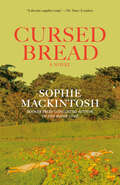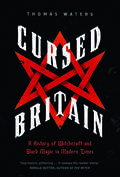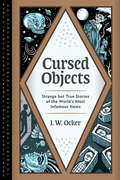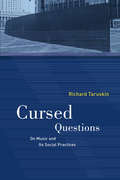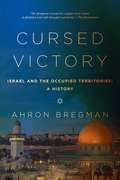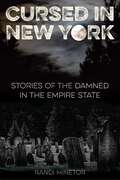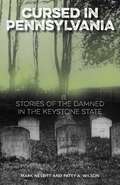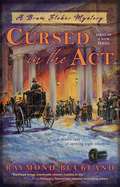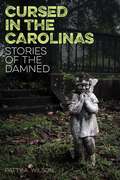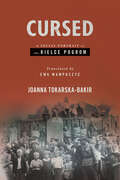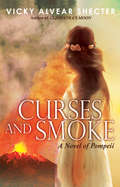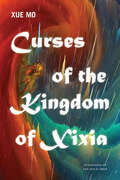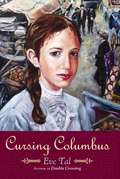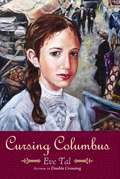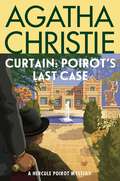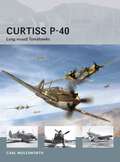- Table View
- List View
Cursed Blessings: Sex and Religious Radical Dissent in Early Modern Europe (Routledge Studies in Early Modern Religious Dissents and Radicalism)
by Umberto GrassiCursed Blessings explores the relationship between sexual nonconformity and religious radical dissent in the early modern Western European world. While many studies have been devoted to the process of the "hereticalization" of nonnormative sexual practices and its use in anti-heretical propaganda, this book is entirely devoted to understanding the meaning of unconventional sexual behaviors from the perspective of the dissenters.Divided into three parts, the first focuses on the Italian peninsula and explores alternative views on sexuality inspired by Renaissance currents of anti-clericalism, ancient Christian heresies, traditions of apocrypha of the New Testament, and Rabbinic literature. It also examines how embodied and gendered experiences influenced the dissenting views of religious women. The second part explores how reflections on Original Sin led to the questioning of Christian assumptions regarding sex and gender, highlighting the relationship between the criticism of sexual morality and disputes on free will, spirituality, and redemption. The third part examines how most of these threads were entwined into a more coherent philosophical framework in the writings of seventeenth- and eighteenth-century erudite libertines.This book is designed for academic readers, including graduate and undergraduate students. Given its intersectional approach, it will be of interest to researchers, teachers, and students in a wide array of fields, including religious, gender, and sexuality studies, as well as literature. This book also tackles issues that are relevant to present-day debates, such as the problematic relations between sexuality and religion and the ongoing polemics surrounding the complicated interactions between religion and politics.
Cursed Bread: A Novel
by Sophie Mackintosh*LONGLISTED FOR THE WOMEN&’S PRIZE FOR FICTION*From the Booker Prize-nominated author of The Water Cure comes a chilling new feminist fable based on the true story of an unsolved mystery...If you eat the bread, you'll die, he said. The statement made no sense, but it filled me with an electric dread.Elodie is the baker's wife. A plain, unremarkable woman, ignored by her husband and underestimated by her neighbours, she burns with the secret desire to be extraordinary. One day a charismatic new couple appear in town--the ambassador and his sharp-toothed wife, Violet--and Elodie quickly falls under their spell. All summer long she stalks them through the shining streets: inviting herself into their home, eavesdropping on their coded conversations, longing to be part of their world.Meanwhile, beneath the tranquil surface of daily life, strange things are happening. Six horses are found dead in a sun-drenched field, laid out neatly on the ground like an offering. Widows see their lost husbands walking up the moonlit river, coming back to claim them. A teenage boy throws himself into the bonfire at the midsummer feast. A dark intoxication is spreading through the town, and when Elodie finally understands her role in it, it will be too late to stop.Audacious and mesmerising, Cursed Bread is a fevered confession, an entry into memory's hall of mirrors, a fable of obsession and transformation. Sophie Mackintosh spins a darkly gleaming tale of a town gripped by hysteria, envy like poison in the blood, and desire that burns and consumes.
Cursed Bread: A Novel
by Sophie MackintoshWOMEN'S PRIZE FOR FICTION NOMINEE • Best Book of the Month: The Washington Post, Los Angeles Times, The Philadelphia Inquirer, Book Riot, CrimeReads • An elegant and hypnotic new novel of obsession that centers on the real unsolved mystery of the 1951 mass poisoning of a French village, by the Booker Prize–nominated author of The Water Cure"Intoxicating, sumptuous, and savage.&”—Alexandra Kleeman, acclaimed author of Something New Under the SunStill reeling in the aftermath of the deadliest war the world had ever seen, the small town of Pont-Saint-Esprit collectively lost its mind. Some historians believe the mysterious illness and violent hallucinations were caused by spoiled bread; others claim it was the result of covert government testing on the local population.In that town lived a woman named Elodie. She was the baker&’s wife: a plain, unremarkable person who yearned to transcend her dull existence. So when a charismatic new couple arrived in town, the forceful ambassador and his sharp-toothed wife, Violet, Elodie was quickly drawn into their orbit. Thus began a dangerous game of cat and mouse--but who was the predator and on whom did they prey?Audacious and mesmerizing, Cursed Bread is a fevered confession, an entry into memory&’s hall of mirrors, and an erotic fable of transformation. Sophie Mackintosh spins a darkly gleaming tale of a town gripped by hysteria, envy like poison in the blood, and desire that burns and consumes.
Cursed Britain: A History of Witchcraft and Black Magic in Modern Times
by Thomas WatersThe definitive history of how witchcraft and black magic have survived, through the modern era and into the present dayCursed Britain unveils the enduring power of witchcraft, curses and black magic in modern times. Few topics are so secretive or controversial. Yet, whether in the 1800s or the early 2000s, when disasters struck or personal misfortunes mounted, many Britons found themselves believing in things they had previously dismissed – dark supernatural forces. Historian Thomas Waters here explores the lives of cursed or bewitched people, along with the witches and witch-busters who helped and harmed them. Waters takes us on a fascinating journey from Scottish islands to the folklore-rich West Country, from the immense territories of the British Empire to metropolitan London. We learn why magic caters to deep-seated human needs but see how it can also be abused, and discover how witchcraft survives by evolving and changing. Along the way, we examine an array of remarkable beliefs and rituals, from traditional folk magic to diverse spiritualities originating in Africa and Asia. This is a tale of cynical quacks and sincere magical healers, depressed people and furious vigilantes, innocent victims and rogues who claimed to possess evil abilities. Their spellbinding stories raise important questions about the state’s role in regulating radical spiritualities, the fragility of secularism and the true nature of magic.
Cursed Legacy: The Tragic Life of Klaus Mann
by Frederic SpottsSon of the famous Thomas Mann, homosexual, drug-addicted, and forced to flee from his fatherland, the gifted writer Klaus Mann’s comparatively short life was as artistically productive as it was devastatingly dislocated. Best-known today as the author of Mephisto, the literary enfant terrible of the Weimar era produced seven novels, a dozen plays, four biographies, and three autobiographies—among them the first works in Germany to tackle gay issues—amidst a prodigious artistic output. He was among the first to take up his pen against the Nazis, as a reward for which he was blacklisted and denounced as a dangerous half-Jew, his books burnt in public squares around Germany, and his citizenship revoked. Having served with the U.S. military in Italy, he was nevertheless undone by anti-Communist fanatics in Cold War-era America and Germany, dying in France (though not, as all other books contend, by his own hand) at age forty-two. Powerful, revealing, and compulsively readable, this first English-language biography of Klaus Mann charts the effects of reactionary politics on art and literature and tells the moving story of a supreme talent destroyed by personal circumstance and the seismic events of the twentieth century.
Cursed Objects: Strange but True Stories of the World's Most Infamous Items
by J. W. OckerBeware...this book is cursed! These strange but true stories of the world&’s most infamous items will appeal to true believers as well as history buffs, horror fans, and anyone who loves a good spine-tingling tale. They&’re lurking in museums, graveyards, and private homes. Their often tragic and always bizarre stories have inspired countless horror movies, reality TV shows, novels, and campfire tales. They&’re cursed objects, and all they need to unleash a wave of misfortune is . . . you. Many of these unfortunate items have intersected with some of the most notable events and people in history, leaving death and destruction in their wake. But never before have the true stories of these eerie oddities been compiled into a fascinating and chilling volume. Inside, readers will learn about: • Annabelle the Doll, a Raggedy Ann doll that featured in the horror franchise The Conjuring • The Unlucky Mummy, which is rumored to have sunk the Titanic and kick-started World War I • The Dybbuk box, which was sold on eBay and spawned the horror film The Possession • The Conjured Chest, which has been blamed for fifteen deaths within a single family • The Ring of Silvianus, a Roman artifact believed to have inspired J. R. R. Tolkien&’s The Hobbit • And many more!
Cursed Questions: On Music and Its Social Practices
by Richard TaruskinRichard Taruskin’s sweeping collection of essays distills a half century of professional experience, demonstrating an unparalleled insider awareness of relevant debates in all areas of music studies, including historiography and criticism, representation and aesthetics, musical and professional politics, and the sociology of taste. Cursed Questions, invoking a famous catchphrase from Russian intellectual history, grapples with questions that are never finally answered but never go away. The writings gathered here form an intellectual biography that showcases the characteristic wit, provocation, and erudition that readers have come to expect from Taruskin, making it an essential volume for anyone interested in music, politics, and the arts.
Cursed Victory: A History of Israel and the Occupied Territories, 1967 to the Present
by Ahron BregmanAn authoritative and impassioned history of the aftermath of the Six Day War--by a former Israeli soldier--and a cogent argument for an end to the occupation. In a move that would forever alter the map of the Middle East, Israel captured the West Bank, Golan Heights, Gaza Strip and Sinai Peninsula in 1967's brief but pivotal Six Day War. Cursed Victory is the first complete history of the war's troubled aftermath--a military occupation of the Palestinian territories that is now well into its fifth decade. Drawing on unprecedented access to high-level sources, top-secret memos and never-before-published letters, the book provides a gripping and unvarnished chronicle of how what Israel promised would be an 'enlightened occupation' quickly turned sour, and the anguished diplomatic attempts to bring it to an end. Bregman sheds fresh light on critical moments in the peace process, taking us behind the scenes as decisions about the fate of the territories were made, and more often, as crucial opportunities to resolve the conflict were missed. As the narrative moves from Jerusalem to New York, Oslo to Beirut, and from the late 1960s to the present day, Cursed Victory provides vivid portraits of the key players in this unfolding drama, including Moshe Dayan, King Hussein of Jordan, Bill Clinton, and Yasser Arafat. Yet Bregman always reminds us how diplomatic and back-room negotiations affected the daily lives of millions of Arabs, and how the Palestinian resistance, especially during the first and second intifadas, and now in recent tragic developments, have shaped the political arena. As Bregman concludes, the occupation has become a dark stain on Israel's history. Cursed Victory is essential reading for anyone who wants to understand the origins of the ongoing conflict in the region.
Cursed in New England: More Stories of Damned Yankees
by Joseph A. CitroNew Englanders are always cursing. But a colorful profanity uttered by some stero-typically taciturn old Yankee is usually more humorous than menacing. Yet, true maledictions (the opposite of benedictions) have frequently been spoken on New England soil, curses intended to invoke evil, injury, or total destruction against other people. Stories about preternatural revenge are numerous in Yankee lore, with each New England state providing its favorites. You&’ll read about curses that were followed by the strange disappearance of a father and daughter in Rhode Island, mysterious afflictions in Massachusetts, a river of death in Maine, an unaccountable blight in New Hampshire, unexplained madness in Connecticut, and other eerie happenings from New England&’s colorful history. Some are well known, at least regionally. Others are nearly forgotten. Within these pages, storyteller Joseph A. Citro vividly brings these tales to life, letting us decide if these tales of woe were bad luck or . . . something else.
Cursed in New York: Stories of the Damned in the Empire State (Cursed)
by Randi MinetorA collection of riveting stories about preternatural revenge. Discover the riveting stories about Queen Esther and the Iroquois Slaughter, The Curse of Mamie O&’Rourke, The Rangers, the Stanley Cup and the Curse of 1940, The Death of a President and the City that Fails to Thrive, and many more. Some stories will be regionally well known. Others are nearly forgotten. All are cursed.
Cursed in Pennsylvania: Stories of the Damned in the Keystone State (Cursed)
by Mark Nesbitt Patty A. WilsonIn Cursed in Pennsylvania, Mark Nesbitt and Patty A. Wilson recount tales of genuine maledictions intended to invoke evil and unease across the state the Keystone State. The pages will bring to life these stories, letting you decide whether the resulting tragedies were simply bad luck, coincidences…or something far more sinister.
Cursed in Virginia: Stories of the Damned in the Old Dominion State (Cursed)
by Mark NesbittIn Cursed in Virginia, Mark Nesbitt recounts tales of genuine maledictions intended to invoke evil and unease across the state the Old Dominion State. The pages will bring to life these stories, letting you decide whether the resulting tragedies were simply bad luck, coincidences…or something far more sinister.
Cursed in the Act (Bram Stocker Mystery #1)
by Raymond BucklandFIRST IN A NEW SERIES! Bram Stoker, business manager for London's Lyceum Theatre, always expects the supernatural to be lurking around the corner. But investigating the murder of a cast member might be enough to make even him lose his head... 1881. When the star and owner of the Lyceum, Mr. Henry Irving, is poisoned on Hamlet's opening night, it's up to stage manager Harry Rivers to make sure the show goes on. Fortunately for Harry, Mr. Irving is able to pull through and walk the boards as planned. But when his understudy is killed the very next day, Harry's boss, Bram Stoker, becomes convinced that foul play is afoot. Mr. Irving has a list of enemies longer than a Shakespearean soliloquy, any of whom would have been happy for the curtain never to rise. It soon becomes clear that nefarious, possibly magical, methods are being employed to shut the play down. With more cast and crew members falling victim to the increasingly dangerous accidents on set, it's up to Harry and Stoker to figure out which of Irving's critics has a voodoo vendetta...
Cursed in the Carolinas: Stories of the Damned (Cursed)
by Patty A. WilsonIn Cursed in the Carolinas, Patty A. Wilson recounts tales of genuine maledictions intended to invoke evil and unease across both North and South Carolina. The pages will bring to life these stories, letting you decide whether the resulting tragedies were simply bad luck, coincidences…or something far more sinister.
Cursed: A Social Portrait of the Kielce Pogrom
by Joanna Tokarska-BakirIn Cursed, Joanna Tokarska-Bakir investigates the July 4, 1946, Kielce pogrom, a milestone in the periodization of the Jewish diaspora. This massacre compelled thousands of Polish Jews who survived the Holocaust to flee postwar Poland. It remains a negative reference point in the Polish historical narrative and represents a lack of reckoning with the role of antisemitism in postwar Polish society and identity politics. Tokarska-Bakir weaves together the voices of the Kielce pogrom survivors, witnesses, and perpetrators with a myriad of other archival sources. Her meticulous research exposes wartime and postwar biographies of local factory workers, city and church officials, local police officers, and members of the security service, some of whom participated in the Holocaust and then directly or indirectly participated in the Kielce pogrom. Tokarska-Bakir paints a social portrait that explores people's behavior in light of forces and emotions greater than themselves. She reconstructs a postwar communist system that, despite promises to combat deeply rooted antisemitism, not only failed to prevent its spread but turned a blind eye to it and eventually used it to legitimize itself. Cursed is a microhistory that recreates the events of the Kielce pogrom step by step and examines the dominant hypotheses about the pogrom through the prism of previously classified archival evidence. It offers readers a nuanced analysis that cuts across social and ideological divisions. The resulting narrative is filled with new discoveries not only about the Kielce pogrom but about the nature of antisemitism, hostility toward minorities, and collective violence.Published in Association with the United States Holocaust Memorial Museum.
Curses and Smoke: A Novel of Pompeii
by Vicky Alvear ShecterWhen your world blows apart, what will you hold onto?TAG is a medical slave, doomed to spend his life healing his master's injured gladiators. But his warrior's heart yearns to fight in the gladiator ring himself and earn enough money to win his freedom.LUCIA is the daughter of Tag's owner, doomed by her father's greed to marry a much older Roman man. But she loves studying the natural world around her home in Pompeii, and lately she's been noticing some odd occurrences in the landscape: small lakes disappearing; a sulfurous smell in the air. . . . When the two childhood friends reconnect, each with their own longings, they fall passionately in love. But as they plot their escape from the city, a patrician fighter reveals his own plans for them -- to Lucia's father, who imprisons Tag as punishment. Then an earthquake shakes Pompeii, in the first sign of the chaos to come. Will they be able to find each other again before the volcano destroys their whole world?
Curses of the Kingdom of Xixia (Excelsior Editions)
by Xue MoXue Mo's novel Curses of the Kingdom of Xixia presents a rich tapestry of the history, religion, lore, and customs of a region in present-day northwestern China. During its heyday, the Sino-Tibetan kingdom of Xixia (pronounced see-sia; 1038–1227), also known as the Tanguts, rivaled the Song dynasty (960–1279) of China and boasted a cavalry so formidable that the Chinese paid tribute to it to maintain peace. Using the discovery of "lost" manuscripts as a frame, the novel presents historical events and tales of semifictional characters, including the avatar of a local Tantric Buddhist goddess, a Dakini/Vajrayogini named Snow Feather. Taking the readers through different historical times and the various geographical and cultural spaces of the region, Xue Mo reveals truths by blurring the distinction between good and evil, beauty and hideousness, reality and fiction, permanence and impermanence. Magical realism and mimesis coexist. Reality merges with illusion, the mundane with the supernatural.
Cursing Columbus
by Eve TalIn 1908, fourteen-year-old Raisel, who has lived in New York City for three years, and her brother Lemmel, newly-arrived, respond very differently to the challenges of living as Ukrainian Jews.
Cursing Columbus
by Eve TalThe dream was always the same: I was back in Russia. My family was sitting around the Sabbath table: Mama, Papa, baby Hannah and my brothers Lemmel and Shloyme. I was telling a story about America--there were gold streets and chickens roosting in trees. Suddenly, Papa and I were on board a ship sailing far away. Ahead I saw the Statue of Liberty towering over the harbor of New York, but she raised her hand high above her head to stop us. I looked around for Papa. I was all alone.Then I woke up and remembered.Papa and I had arrived at Ellis Island. For three years we had been living on the Lower East Side of New York. Papa worked in a sweatshop earning money to bring over the rest of the family, while I worked after school. I dreamed of the day our family would be together again.And tomorrow, it would finally happen. Would they love America like I did or would they say "a curse on Columbus" because the New World brought them nothing but trouble and hard work?Eve Tal was born in the United States, but lives on Kibbutz Hatzor in Israel. Cursing Columbus is her second young adult historical novel and is the sequel to Double Crossing, which is based on her grandfather's emigration story from the Ukraine.
Cursing, Crisis and Customary Knowledge in Early Modern English Townships (Palgrave Historical Studies in Witchcraft and Magic)
by Karen O'BrienThis book provides a historical and socio-legal investigation into the prevalence of litigation arising from cursing and interpersonal hostility in the under-explored region of Northwest England during a period of acute socio-economic crisis in the seventeenth century. Contributing to the scholarship of magic and witchcraft, it shows the complex circumstances of the world of healing and harming using customary knowledge such as magic and folk medicine as it is variously presented in the documents of the legal system. While primary sources such as pamphlets have usefully informed numerous witchcraft studies, this book establishes popular belief derived from the depositions, interrogatories and various other manuscripts of the manorial, ecclesiastical and secular courts positioned within a micro historical early modern context.
Curt Flood in the Media: Baseball, Race, and the Demise of the Activist-Athlete (Race, Rhetoric, and Media Series)
by Professor Abraham Iqbal KhanCurt Flood in the Media examines the public discourse surrounding Curt Flood (1938–1997), the star centerfielder for the St. Louis Cardinals throughout the sixties. In 1969, Flood was traded to the Philadelphia Phillies. At the time, all Major League Baseball players were subject to the reserve clause, which essentially bound a player to work in perpetuity for his original team, unless traded for another player or sold for cash, in which case he worked under the same reserve conditions for the next team. Flood refused the trade on a matter of principle, arguing that Major League Baseball had violated both US antitrust laws and the 13th Amendment's prohibition of involuntary servitude. In a defiant letter to Commissioner Bowie Kuhn asking for his contractual release, Flood infamously wrote, “after twelve years in the major leagues, I do not feel that I am a piece of property to be bought and sold irrespective of my wishes.” Most significantly, Flood appeared on national television with Howard Cosell and described himself as a “well-paid slave.” Explosive controversy ensued. Khan examines the ways in which the media constructed the case and Flood's persona. By examining the mainstream press, the Black press, and primary sources, including Flood's autobiography, Khan exposes the complexities of what it means to be a prominent Black American athlete—in 1969 and today.
Curtain: A Hercule Poirot Mystery: The Official Authorized Edition (Hercule Poirot Mysteries #37)
by Agatha ChristieThe legendary detective saves his best for last as he races to apprehend a five-time killer before the final curtain descends in Curtain: Poirot’s Last Case, the last book Agatha Christie published before her death.The crime-fighting careers of Hercule Poirot and Captain Hastings have come full circle—they are back once again in the rambling country house in which they solved their first murder together.Both Hercule Poirot and Great Styles have seen better days—but, despite being crippled with arthritis, there is nothing wrong with the great detective and his “little gray cells.” However, when Poirot brands one of the seemingly harmless guests a five-time murderer, some people have their doubts. But Poirot alone knows he must prevent a sixth murder before the curtain falls.
Curtains of Light: Theatrical Space in Film (SUNY series, Horizons of Cinema)
by George TolesGeorge Toles's Curtains of Light explores the ways in which various kinds of theatrical space in film engage with the film reality adjacent to them, and alter our understanding of the cinematic real. Film art is a dialogue between the world created for a film narrative and theatre spaces that confront it across the shadowline. This book provides a new way of thinking about film's relation to theatre, and challenges old conceptions of how cinema needs to escape the theatrical, or rise above it. Toles offers elegantly written and jargon-free readings of a rich variety of films, spanning the distance from D.W. Griffith's True Heart Susie up to David Lynch's Mulholland Dr. and Ang Lee's Lust, Caution. The methodology is predominantly aesthetic, but informed by Toles's decades of experience as a professional theatre director. Among the many topics covered are audition scenes, stage deaths on film, the close up and theatrical aloneness in film, eloquent objects, and characters who alternate between directing and playacting for each other, with tragic consequences. Curtains of Light would be an extremely useful introductory text for university students studying the relationship of cinema to theatre.
Curtiss P-40 - Long-nosed Tomahawks
by Carl MolesworthThe initial version of the Curtiss P-40, designated by the manufacturer as the Hawk H-81, combined the established airframe of the earlier radial-powered H-75 (P-36) fighter with the Allison V-1710 liquid-cooled engine. The year was 1939, and the marriage was one of expediency. With the threat of war in Europe growing by the day, the US Army Air Corps brass wanted a modern fighter that would combine the sterling handling qualities of the P-36 with a boost in performance that would make it competitive with the new types emerging in Germany and England, and the generals wanted the new plane immediately. The P-40 delivered admirably, and though it never reached the performance levels of the Bf 109 or Spitfire, the sturdy fighter nevertheless made a place in history for itself as the Army's frontline fighter when the US entered World War II. Long-nosed P-40s initially saw combat in North Africa, flying in Royal Air Force squadrons. They also fought in the skies over Pearl Harbor and the Philippines. But the long-nosed P-40 is best known as the shark-faced fighter flown by the American Volunteer Group - the legendary Flying Tigers - over Burma and China during 1941-42.
Curtiss P-40 -Snub-nosed Kittyhawks and Warhawks
by Carl Molesworth Adam ToobyAn improved version of the Allison V-1710 engine gave rise to the Curtiss H-87, which began life in 1941 as the P-40D and featured a completely redesigned fuselage. The shorter and deeper nose of the new fighter gave it a decidedly snub-nosed appearance compared to the earlier P-40 models. Curtiss continued to tweak the H-87 for the next two years in the search for better performance, but the last major version, the P-40N, was only marginally faster than the first. In the process, Curtiss even tried an engine change to the Packard Merlin in the P-40F and L but to no avail. What the late model P-40s lacked in speed and service ceiling, they traded for maneuverability, durability and availability. Their niche became fighter-bomber operations, and they fought on fronts as varied as the arctic wastes of the Aleutian Islands and Iceland, the steaming jungles of the South Pacific and the barren deserts of North Africa. P-40s were a common sight in the skies over Burma and China, Sicily and Italy, and western Russia as well. By the time production ceased in 1944, Curtiss had produced nearly 14,000 P-40s.


